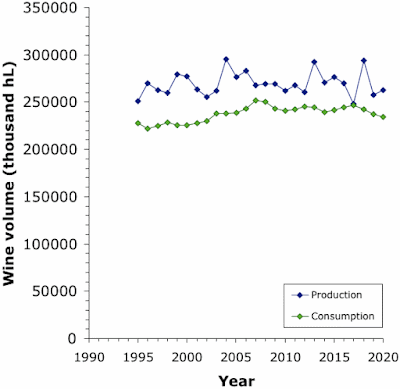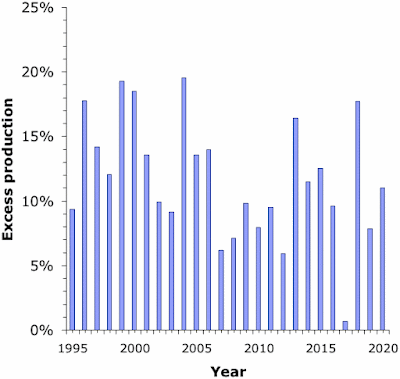A couple of weeks ago, I pondered the obvious similarity between
The alcohol industry and the car industry, comparing the issue of who takes responsibility for societal consequences; and before that, I presented some data showing that one-quarter of wine makers cannot put a legal label on a bottle properly (
Regulatory compliance is not something that the alcohol industry is good at). To me, this raises a more general question about social responsibility in the wine industry. So, I will ponder a range of potential topics here.
As I previously discussed, labels are the first point of communication from the producer. As far as these labels are concerned, there is now societal pressure insisting on some quite basic information to be placed on these labels, which is currently missing. Personally, I think that alcohol can reasonably be treated as “food” (I put it in my body, with the intention of metabolizing it), and so it should contain all of the same information as other food. How can anyone argue for an exception? However, apparently people have done so. *
I was recently invaded by a group of children, and amongst the wreckage of my house there was a half-empty container of micro-popcorn. It’s label includes information about the ingredients (corn kernels, palm oil, salt), as well as the percentage content of: Fat, Carbohydrate (with Sugars listed separately), Fiber, Protein, and Salt, plus the Energy value (kJ or kcal). Why do alcohol containers not contain this same sort of basic information? The industry would look more responsible if they did have it.
Moreover, some of the terms that actually
are used on wine labels are a bit disingenuous. What, for crying out loud, does “organic” mean? It is becoming more and more obvious that it can mean many things, depending on the mood of the advertising requirements. So, we now have this unfortunate situation:
Is criticism of organic or sustainable wine-growing programs adding to consumers’ distrust or confusion? The answer is all too obvious.
It goes further, of course, since almost any word can be used on a bottle label, including “clean” and “natural” (
We need to talk about “clean,” “organic,” and “natural” wine). Not all of these terms stand up to scrutiny (
PURE lies: winemaker Adam Lee puts a ‘clean wine’ to the test). In a responsible industry, they would do so; and the industry has already received an official warning (
‘Clean’ wine marketing draws warnings from regulatory agency).
In addition to this issue of production techniques, there is also the old problem of wine regional names, and their use on labels. As but one recent example, see this:
When does a wine qualify for Napa? Since wine regions are a long-standing topic, I will not pursue it again here.
This brings us to the topic of wine writing, which does not always seem to be as responsible as we might like. Advertisers have always been treated with suspicion, if not contempt, because they have such a blatant agenda. In the past, acceptable wine advertising has varied from country to country, from relatively unconstrained to rather seriously controlled. However, digital advertising has changed all of this, since it operates essentially across all borders. This is an area where irresponsibility could be widespread (
Alcohol marketing has crossed borders and entered the metaverse – how do we regulate the new digital risk?).**
The issue with the media in general has always been, not that they don’t tell the truth, but that don’t tell us
all of the truth, which can be seriously misleading (discussed in
How to read this chart). For a wine industry example, why are writers continually extolling higher quality from new grape-growing regions, when the traditional markets are shrinking, younger people do not drink much wine***, and production already exceeds consumption (
Global wine consumption has been declining for a long time)? Beats me!
We also have wine writers selling the wines they review, or making the wines they review, or simply knowing nothing specific about wine in the first place. The latter has become particularly problematic in the modern world of social media. This has been referred to as:
The incurable plague of wine influencers. The issue here is that, in a responsible industry, we should be:
Looking for context, insight and knowledge among wine influencers; and yet we get very little of any of these things. Wine’s ’
social experts’ may be expert at being social, but so many of them are not experts at wine. They all have opinions, but there is no substance behind those opinions.
In addition to this, there is the matter of the writing associated with ordering wine in pubs, bars and restaurants. Surprise, surprise, wine lists are not considered to be very helpful things, for customers (
Customers are crying out for support when buying wine). Mind you, with computers now capable of writing wine reviews (
Everyone has opinions, even AI), wine writers may already be an endangered species.
It would be foolish to finish without mentioning something that wine industry seems to be addressing responsibly, plus one that I hope they will now also do.
The obvious choice, these days, for responsibility, is global climate change. Changes in grape-growing seasons have long been quantitative evidence for global warming (
Grape harvest dates and the evidence for global warming), as well as the other effects of global climate change (
Grape harvest dates and year-to-year climate variability). The wine industry has not been fast to react (
Why have we left it so late to deal with climate change in the wine industry?), but it has become increasingly obvious that reaction there must be (
The French grape-growers will need to get used to April Weather). Many wine-making regions are now reporting their activities about their changing activities (eg.
Australian wine businesses moving ahead to tackle climate change).
One area where I think that more reaction is needed is the matter of wine containers; and I hope that responsibility takes precedence over the traditional use of glass bottles (
Will tradition prevent the wine industry from embracing sustainability?). Glass was a great idea
in its day; but that day started 4,000 years ago, and ended with the advent of global climate change (wine first appeared in bottles in the 1600s, after 7,000 years of making wine). The energy required even to recycle glass is massive, let alone to make it from sand in the first place. Aluminum cans (which have been around
since the 1930's) and PET bottles are clearly much better in this regard, as are Tetra-pacs and bag-in-box (
Life cycle assessment of beverage packaging). An alternative would be to re-fill the used bottles (as was done for milk delivery, when I was young), instead of treating them as single use (
These are the top 5 most sustainable drink containers ranked). Even worse, the energy used to transport glass is pretty serious, since it is heavier than aluminum and PET. The days are clearly numbered for the use of millions of glass wine bottles every year (
Ranked: the environmental impact of five different soft drink containers); and the sooner we face this, then the more socially responsible we will be.
So, what might we conclude from all of this navel gazing? The alcohol industry is certainly not perceived as being near the top of the pecking order, with regard to social responsibility. This is a pity, especially for the wine industry, which has always tried to position itself as a valued part of society, and which is now genuinely trying to make progress. We still have quite some way to go, I think.
*
Ingredient labeling: a look back: “When all foods in the U.S. were required to list ingredients on their labels, the alcohol beverage producers led by the wine industry lobbied hard and effectively to be excluded from the requirement. The wine industry is legally defined as a food industry and as such, for example, during C
OVID, has been permitted to continue their agricultural and wine production work.” This exemption allows them, for example, to ignore the inclusion this:
Mega Purple is the wine ingredient nobody will talk about.
** The metaverse consists of digital representations of people, places and things, including wine brands, inhabited by virtual experiences, information and goods (
The metaverse and your wine brands). Since it is not real, the scope for irresponsibility is great.
*** Since the ’90s, the number of wineries in the United States has tripled, yet the volume output has only doubled. Because the industry has seen a disproportionate influx of smaller wineries that are producing their wines at a higher cost, younger consumers are being priced out (
What the wine industry gets wrong about marketing to younger generations).















